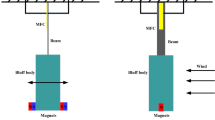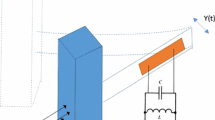Abstract
In this study, the electromechanical equation of motion for a galloping-based energy harvesting system is derived and experimentally validated. This system consists of a bluff body that elastically mounted in fluid flow and a piezoelectric energy harvesting device, which is placed inside it. To confirm dynamic behavior of the system in fluid flow, periodic response of the variables is analytically obtained by employing the harmonic balance method. The validated equations are used to study effect of changing the system parameters on electromechanical behavior of the energy harvester. Then, application of the system is investigated in a realistic condition. Employing several user-oriented charts, the energy harvesting system is optimized and it is shown that this system can optimally be used in normal wind speed.













Similar content being viewed by others
References
Arnold, D.P.: Review of microscale magnetic power generation. IEEE Trans. Magn. 43(11), 3940–3951 (2007)
Afsharfard, A.: Application of nonlinear magnetic vibro-impact vibration suppressor and energy harvester. Mech. Syst. Signal Process. 98, 371–381 (2018)
Mitcheson, P.D., et al.: MEMS electrostatic micropower generator for low frequency operation. Sens. Actuators A Phys. 115(2), 523–529 (2004)
Ravi, S., Zilian, A.: Monolithic modeling and finite element analysis of piezoelectric energy harvesters. Acta Mech. 228(6), 2251–2267 (2017)
Cook-Chennault, K., Thambi, N., Sastry, A.: Powering MEMS portable devices—a review of non-regenerative and regenerative power supply systems with special emphasis on piezoelectric energy harvesting systems. Smart Mater. Struct. 17(4), 043001 (2008)
Afsharfard, A., Farshidianfar, A.: Application of single unit impact dampers to harvest energy and suppress vibrations. J. Intell. Mater. Syst. Struct. 25, 1850–1860 (2014)
Abdelkefi, A.: Aeroelastic energy harvesting: a review. Int. J. Eng. Sci. 100, 112–135 (2016)
Farshidianfar, A., Zanganeh, H.: A modified wake oscillator model for vortex-induced vibration of circular cylinders for a wide range of mass-damping ratio. J. Fluids Struct. 26(3), 430–441 (2010)
Abdelkefi, A., Nayfeh, A., Hajj, M.: Enhancement of power harvesting from piezoaeroelastic systems. Nonlinear Dyn. 68(4), 531–541 (2012)
Hémon, P., Amandolese, X., Andrianne, T.: Energy harvesting from galloping of prisms: a wind tunnel experiment. J. Fluids Struct. 70, 390–402 (2017)
Bibo, A.: Investigation of concurrent energy harvesting from ambient vibrations and wind, PhD thesis, Clemson University (2014)
Akaydin, H., Elvin, N., Andreopoulos, Y.: The performance of a self-excited fluidic energy harvester. Smart Mater. Struct. 21(2), 025007 (2012)
Yan, Z., Abdelkefi, A.: Nonlinear characterization of concurrent energy harvesting from galloping and base excitations. Nonlinear Dyn. 77(4), 1171–1189 (2014)
Piccardo, G., Pagnini, L.C., Tubino, F.: Some research perspectives in galloping phenomena: critical conditions and post-critical behavior. Contin. Mech. Thermodyn. 27(1–2), 261–285 (2015)
Hartog, D.J.: Mechanical Vibrations. McGraw-Hill Book Company, New York City (1956)
Barrero-Gil, A., Alonso, G., Sanz-Andres, A.: Energy harvesting from transverse galloping. J. Sound Vib. 329(14), 2873–2883 (2010)
Novak, M.: Aeroelastic galloping of prismatic bodies. J. Eng. Mech. Div. 95(1), 115–142 (1969)
Parkinson, G.: Phenomena and modelling of flow-induced vibrations of bluff bodies. Prog. Aerosp. Sci. 26(2), 169–224 (1989)
Alonso, G., Meseguer, J.: A parametric study of the galloping stability of two-dimensional triangular cross-section bodies. J. Wind Eng. Ind. Aerodyn. 94(4), 241–253 (2006)
Alonso, G., Meseguer, J., Pérez-Grande, I.: Galloping stability of triangular cross-sectional bodies: a systematic approach. J. Wind Eng. Ind. Aerodyn. 95(9), 928–940 (2007)
Xu-Xu, J., Barrero-Gil, A., Velazquez, A.: Experimental study on transverse flow-induced oscillations of a square-section cylinder at low mass ratio and low damping. Exp. Therm. Fluid Sci. 74, 286–295 (2016)
Xu-Xu, J., Vicente-Ludlam, D., Barrero-Gil, A.: Theoretical study of the energy harvesting of a cantilever with attached prism under aeroelastic galloping. Eur. J. Mech. B Fluids 60, 189–195 (2016)
Abdelkefi, A., Yan, Z., Hajj, M.R.: Performance analysis of galloping-based piezoaeroelastic energy harvesters with different cross-section geometries. J. Intell. Mater. Syst. Struct. 25(2), 246–256 (2014)
Abdelkefi, A., Hajj, M.R., Nayfeh, A.H.: Power harvesting from transverse galloping of square cylinder. Nonlinear Dyn. 70(2), 1355–1363 (2012)
Abdelkefi, A., Yan, Z., Hajj, M.R.: Modeling and nonlinear analysis of piezoelectric energy harvesting from transverse galloping. Smart Mater. Struct. 22(2), 025016 (2013)
Sirohi, J., Mahadik, R.: Piezoelectric wind energy harvester for low-power sensors. J. Intell. Mater. Syst. Struct. 22(18), 2215–2228 (2011)
Daqaq, M.F.: Characterizing the response of galloping energy harvesters using actual wind statistics. J. Sound Vib. 357, 365–376 (2015)
Bibo, A., Abdelkefi, A., Daqaq, M.F.: Modeling and characterization of a piezoelectric energy harvester under combined aerodynamic and base excitations. J. Vib. Acoust. 137(3), 031017 (2015)
Abdelkefi, A., Yan, Z., Hajj, M.R.: Temperature impact on the performance of galloping-based piezoaeroelastic energy harvesters. Smart Mater. Struct. 22(5), 055026 (2013)
Abdelmoula, H., Abdelkefi, A.: The potential of electrical impedance on the performance of galloping systems for energy harvesting and control applications. J. Sound Vib. 370, 191–208 (2016)
Vicente-Ludlam, D., Barrero-Gil, A., Velazquez, A.: Enhanced mechanical energy extraction from transverse galloping using a dual mass system. J. Sound Vib. 339, 290–303 (2015)
Nishi, Y., Fukuda, K., Shinohara, W.: Experimental energy harvesting from fluid flow by using two vibrating masses. J. Sound Vib. 394, 321–332 (2017)
Nishi, Y., et al.: Power extraction using flow-induced vibration of a circular cylinder placed near another fixed cylinder. J. Sound Vib. 333(10), 2863–2880 (2014)
Dai, H.L.: Towards control of cross-flow-induced vibrations based on energy harvesting. Nonlinear Dyn. 88, 1–18 (2017)
Giorgio, I., et al.: Piezo-electromechanical smart materials with distributed arrays of piezoelectric transducers: current and upcoming applications. Int. J. Appl. Electromagn. Mech. 47(4), 1051–1084 (2015)
Hagood, N.W., von Flotow, A.: Damping of structural vibrations with piezoelectric materials and passive electrical networks. J. Sound Vib. 146(2), 243–268 (1991)
Giorgio, I., Culla, A., Del Vescovo, D.: Multimode vibration control using several piezoelectric transducers shunted with a multiterminal network. Arch. Appl. Mech. 79(9), 859 (2009)
Alessandroni, S., et al.: A passive electric controller for multimodal vibrations of thin plates. Comput. Struct. 83(15–16), 1236–1250 (2005)
Erturk, A., Inman, D.J.: Piezoelectric Energy Harvesting. Wiley, New York (2011)
Vicente-Ludlam, D., Barrero-Gil, A., Velazquez, A.: Optimal electromagnetic energy extraction from transverse galloping. J. Fluids Struct. 51, 281–291 (2014)
Abdelkefi, A., Hajj, M., Nayfeh, A.: Piezoelectric energy harvesting from transverse galloping of bluff bodies. Smart Mater. Struct. 22(1), 015014 (2012)
https://www.windfinder.com/windstatistics/mashhad. Accessed 6 June 2017
Author information
Authors and Affiliations
Corresponding author
Additional information
Publisher's Note
Springer Nature remains neutral with regard to jurisdictional claims in published maps and institutional affiliations.
Appendices
Appendix A
The potential energy of each piezoelectric and substructure layer is given in the following equation [39]:
where \(\varepsilon \) and \(\sigma \) are stress and strain, respectively. Also, Note that the integration is over the volume of the structure. Strain and stress can be written as:
This parameter along with electric displacement component \((D_{3})\) and electric field component in z direction \((E_{3})\). The relation, which is named as constitutive equation, is as follows:
Substituting stress and strain relations into (A1), the final form of the potential energy for each piezoelectric and substructure layer is obtained.
Furthermore, using relations of Eq. (A3), the simplified form of internal electrical energy for each piezoelectric layer becomes:
Appendix B
Note that Eqs. (1)–(3) are integrated over the volume. In the first step, by substituting \(w_{\mathrm{b}}t_{\mathrm{b}}\) and \(w_\mathrm{p}t_\mathrm{p}\), respectively, as the surface of beam and piezoelectric layer, Eqs. (1)–(3) are rewritten over the length as follows:
In the second step, by substituting Eqs. (B1)–(B3) into Eqs. (6)–(8) and using the orthogonality conditions, Eqs. (9)–(11) are obtained.
Appendix C
The fundamental Euler–Bernoulli beam equation for ith vibration mode is expressed as follows:
The above equation can be rewritten for rth and sth vibration modes:
Multiplying Eq. (C2) by \(\varphi _{s}(x)\) and integrating over the length of the beam gives:
Integrating the left side of the above equation and using boundary conditions leads to find Eq. (C5). Multiplying Eq. (C3) by \(\varphi _{r}(x)\) and integrating over the length of the beam results in find Eq. (C6):
Regarding to the above equations, in case of two distinctive mode shape (\( r \ne s\)), the following equation can be obtained:
Orthogonality condition can be written as follows:
where \(\delta _{rs}\) is the Kronecker delta, defined as unity for the case of \((r=s)\) and zero for \(( r \ne s\)). Considering the fundamental vibration mode (the first mode shape) Eq. (21) is obtained.
Rights and permissions
About this article
Cite this article
Sobhanirad, S., Afsharfard, A. Improving application of galloping-based energy harvesters in realistic condition. Arch Appl Mech 89, 313–328 (2019). https://doi.org/10.1007/s00419-018-1469-4
Received:
Accepted:
Published:
Issue Date:
DOI: https://doi.org/10.1007/s00419-018-1469-4




